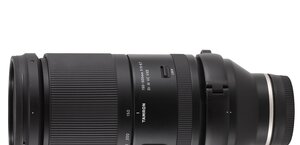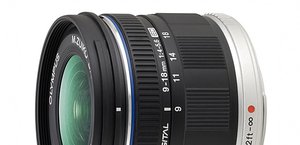Tamron SP 15-30 mm f/2.8 Di VC USD
3. Build quality and image stabilization
In the photo below the tested lens is situated next to the Carl Zeiss Makro-Planar T* 50 mm f/2 and the Sigma A 35 mm f/1.4 DG HSM.
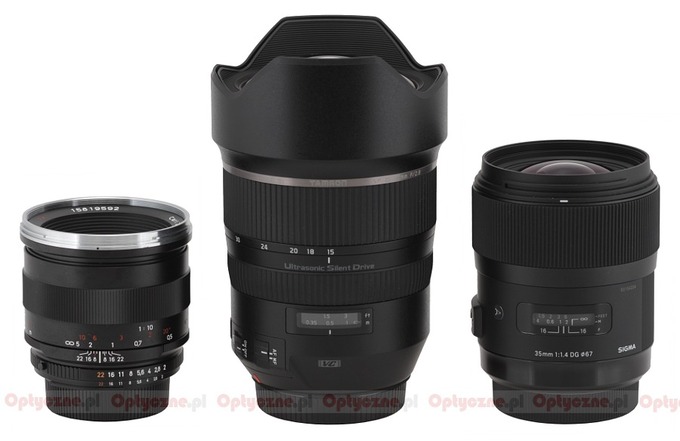 |
Please Support UsIf you enjoy our reviews and articles, and you want us to continue our work please, support our website by donating through PayPal. The funds are going to be used for paying our editorial team, renting servers, and equipping our testing studio; only that way we will be able to continue providing you interesting content for free. |
- - - - - - - - - - - - - - - - - - - - - - - - - - - - - - - - - - - - - - - - - - - - - - - -
The Tamron starts with a metal mount which surrounds a contact plate and a rear element, 26 mm in diameter. The element is movable; it is situated on the same level as the contacts at 15 mm focal length and it hides about 2 cm deep when you pass to 30 mm. Unfortunately some other parts of the inner tube are revealed in the process, including plates with electronic components. Seeing them you cannot even start talking about the lens being air-tight or sealed properly…
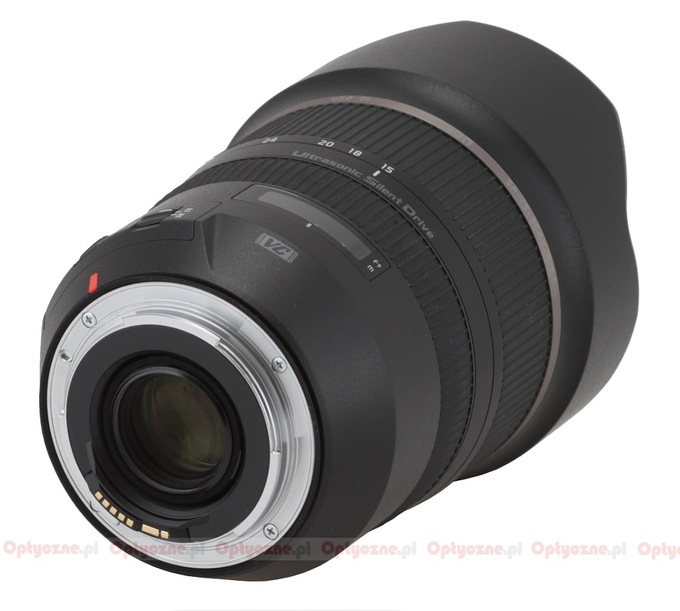 |
The first part of the proper casing of the lens is a red rectangle making an alignment with a camera easier. Next to it you see switches controlling the focusing mechanism (AF/MF) and optical stabilization (VC ON/OFF). Near them you find “VC” letters and above them a distance scale behind a window, expressed in feet and meters.
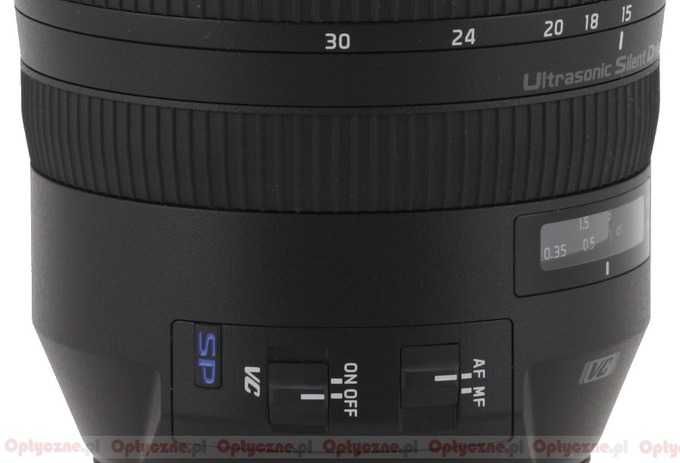 |
The next part is a manual focus ring, 15 mm wide, covered by rubber ribs. It moves smoothly and is well-damped. Running through the whole distance scale takes a turn through an angle of about 110 degrees.
Further on there is a small, immobile fragment of the casing which, on the one side, has an inscription “Ultrasonic Silent Drive” and on the other – the serial number and information that the lens was produced in Japan.
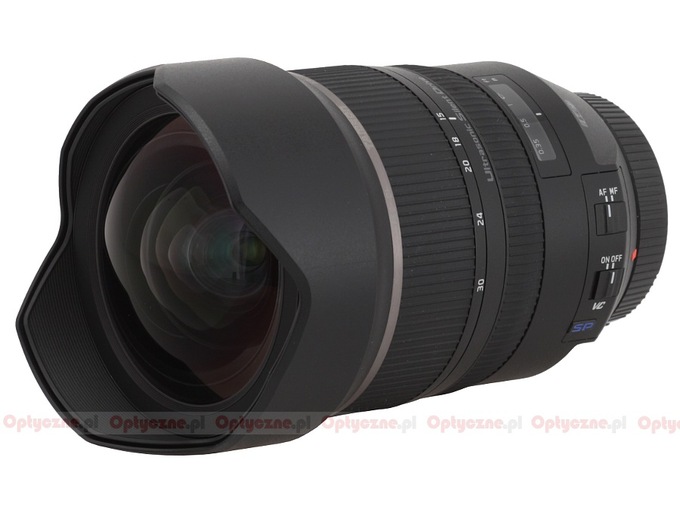 |
The next part is a zoom ring, as wide as 29 mm. Most of it is covered by rubber ribbing and below you see focal length markings at 15, 18, 20, 24 and 30 mm. The ring’s action is even and smooth throughout the whole range. Right behind it there is a titanium-coloured stripe with the name and the parameters of the lens. The stripe turns very smoothly into a built-in, petal-type hood. The front element of the lens is 73 mm in diameter and so convex that there is no possibility of using any filters. It is the most extended at 15 mm and it hides inside the tube at less than 30 mm focal length.
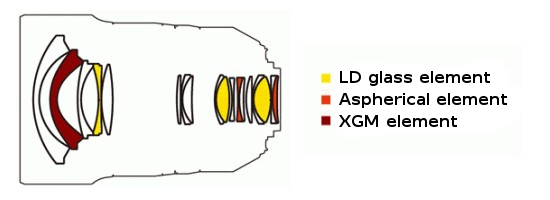 |
When it comes to the inner construction of the lens you deal here with 18 elements positioned in 13 groups. The producer boasts of using three elements made of low-dispersion LD glass and two aspherical elements as well. A big XGM aspherical element ( XGM meaning eXpanded Glass Molded Aspherical) also deserves our attention, along with three different kinds of coatings. Layers of BBAR (Broad-Band Anti-Reflection) and eBAND are supposed to ensure high transmission and correct performance against bright light. Additional protective layers covering the big front element should make it dirt resistant and easy to clean. Inside you can also find a round aperture with nine diaphragm blades which can be closed down to f/22.
Buyers get only two caps in the box. It’s a pity. For such a price the producer could have added a case.
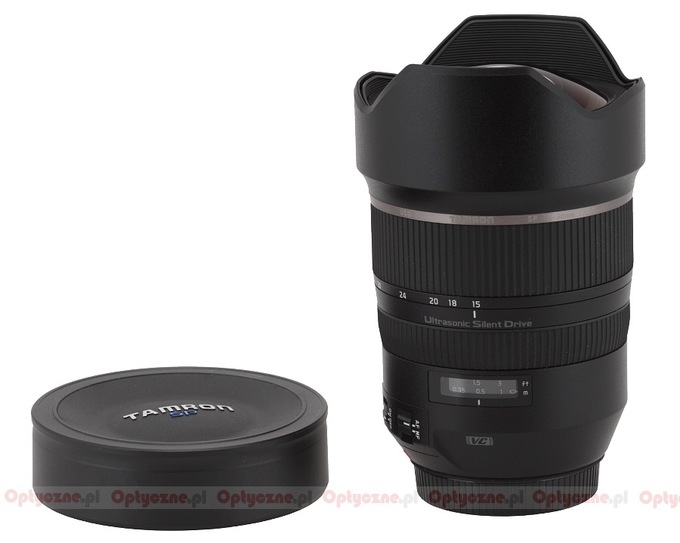 |
Optical stabilization
The optical stabilization test was performed at 30 mm. We took several dozen photos with shutter speeds ranging from 1/40 to 1 second with the stabilization switched on and off. Then we calculated the percentage of blurred photos at every speed and presented the results as exposure time function graph, expressed in EV (with 0 EV being the equivalent of 1/30 of a second). The results can be seen below.
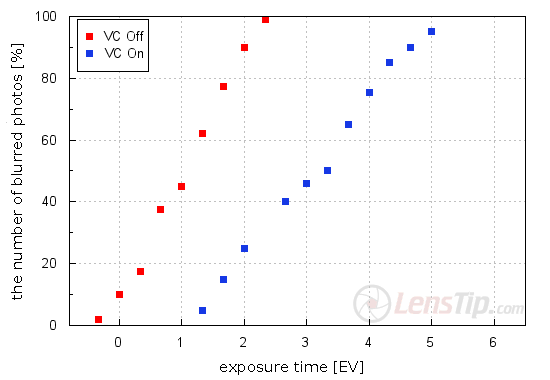
The maximum distance between both curves reaches 2.7 EV and such is, in our opinion, the efficiency of the stabilization mechanism of the Tamron. That value is hardly impressive; still you shouldn’t expect any records from a stabilized lens with short focal lengths. It’s enough to remind here that the Nikkor 16–35 mm VR had a result of 2.5 EV, and the Canon EF 2.8/28 IS - about 3.5 EV. It is understandable up to a point. The 4-4.5 EV efficiency is reached by the best telephoto lenses. If the Tamron wanted to achieve it, it would have to stabilize shutter speeds on a level of 1 second, a very difficult task taking into account the physical dimensions of the lens.




